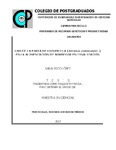Uso de la pasta de higuerilla (Ricinus communis L) en la alimentación de borregos en finalización.
Abstract
En México, se ha intensificado la búsqueda de opciones alimenticias para la producción animal, de bajo costo y alto contenido de proteína, considerando que el rubro de alimentación representa de un 60 a 80% del costo de una unidad de producción. La pasta de higuerilla es un ingrediente que se presenta como una opción para ser utilizado en la formulación de raciones, por su bajo costo y contenido de proteína. El objetivo de este estudio fue evaluar la inclusión de diferentes cantidades de pasta de higuerilla detoxificada en el comportamiento productivo y calidad de la carne de borregos en finalización. Se utilizaron 32 ovinos Katahdin de 29.62 kg promedio de peso vivo inicial (PV), alojados en jaulas metabólicas individuales, durante 90 días que duró el experimento. Se utilizó un diseño completamente al azar con cuatro tratamientos y ocho repeticiones. Los tratamientos fueron: T0= 0 %, T10= 10 %, T15= 15 % y T20= 20 % de inclusión de pasta de higuerilla en las dietas. Se determinó consumo de materia seca (CMS), ganancia diaria de peso (GDP), conversión alimenticia (CA), digestibilidad aparente de la materia seca (DAMS), digestibilidad aparente de la proteína cruda (DAPC) y digestibilidad aparente de la fibra detergente neutra (DAFDN), así como las características de la canal y calidad de la carne. El CMS fue mayor en el T20 de pasta de higuerilla; pero la GDP no fue diferente entre tratamientos (T0=230, T10=230, T15=240, T20=210 g animal dia-1). La CA fue mayor en el T20 (6. 91) comparado con los demás tratamientos, no habiendo diferencia entre ellos (T0=5.53, T10=5.20 y T15=5.45. Las características de la canal y calidad de la carne no fueron afectadas por la inclusión de pasta de higuerilla (P ≤0.05). Incluir pasta de higuerilla hasta en 15 % en dietas para borregos en finalización, no afecta el comportamiento productivo, ni las características de la canal o la calidad de la carne. _______________ USE OF CASTOR BEAN MEAL (Ricinus communis L.) IN DIETS FOR FATTENING LAMBS. ABSTRACT: In Mexico, the search for low-cost and high-protein feed options has intensified, considering that the feed accounts for 60 to 80% of the cost of a production unit, the castor bean meal is an ingredient that can be used for the formulation of rations, by it low cost and the protein content that it presents. The objective of this study was to evaluate the inclusion of different concentrations of castor bean detoxified on productive performance of sheep in finalization. Thirty-two Katahdin sheep with an average live weight (LW) of 29.62 kg, distributed in a completely randomized design into four treatments (eight replicates per treatment). The sheep were housed in individual cages and fed with four isoprotein and isoenergetic diets. The inclusion of castor bean meal was: T0= 0%, T10= 10%, T15= 15% and T20= 20%, during 90 days, with 15 days of adaptation to diets. We estimated the dry matter intake (DMI), Average daily gain (ADG), feed conversion (FC), apparent digestibility dry matter (ADDM), apparent dry matter digestibility (ADMD), apparent digestibility crude protein digestibility (ADCP) and apparent digestibility of neural detergent fiber (ADNDF). In addition, the characteristics of the carcass and meat quality were evaluated. The data were analyzed using the GLM procedure and the means comparison with the Tukey test (P ≤ 0.05). DMI was higher in treatment with 20% of castor bean meal, however, DWG was not affected by treatments having similar weight gains (230, 230, 240, 210 g animal day-1). The FC was 5.53, 5.20, 5.45 and 6.91, respectively. The inclusion of castor bean meal in 10 and 15% in the diet does not affect productive performance of sheep in finalization.
Collections
- Tesis MC, MT, MP y DC [403]
The following license files are associated with this item:


